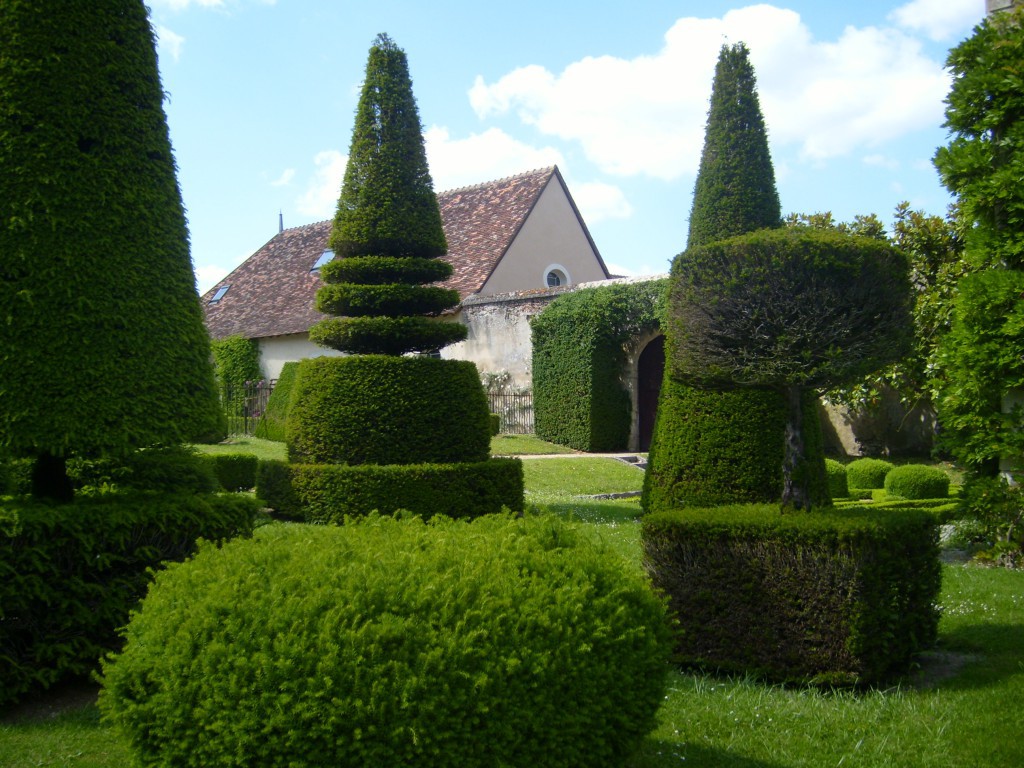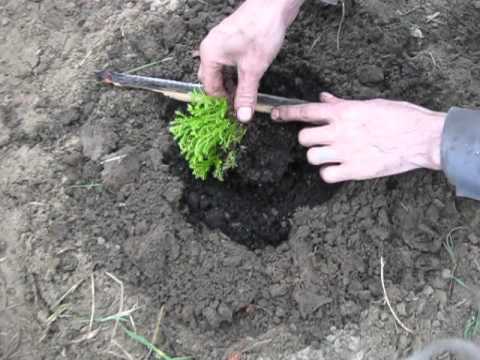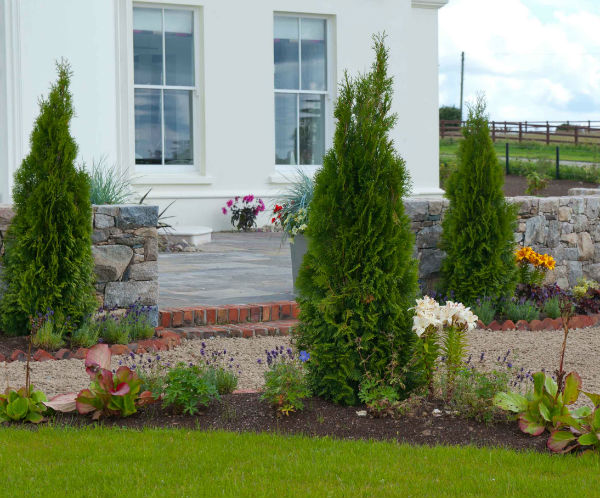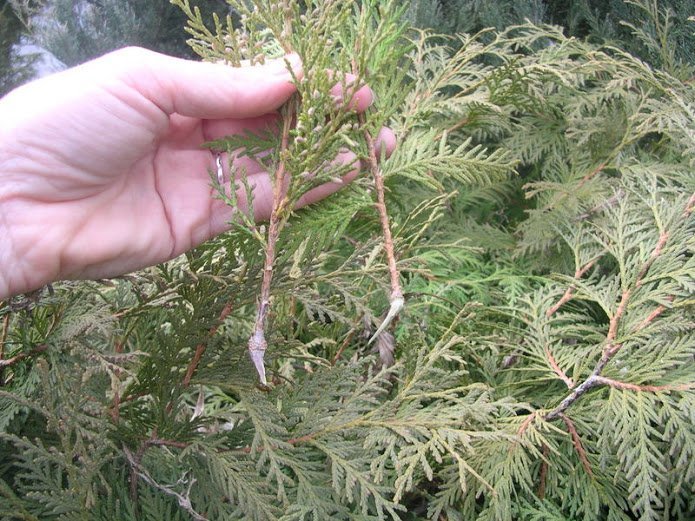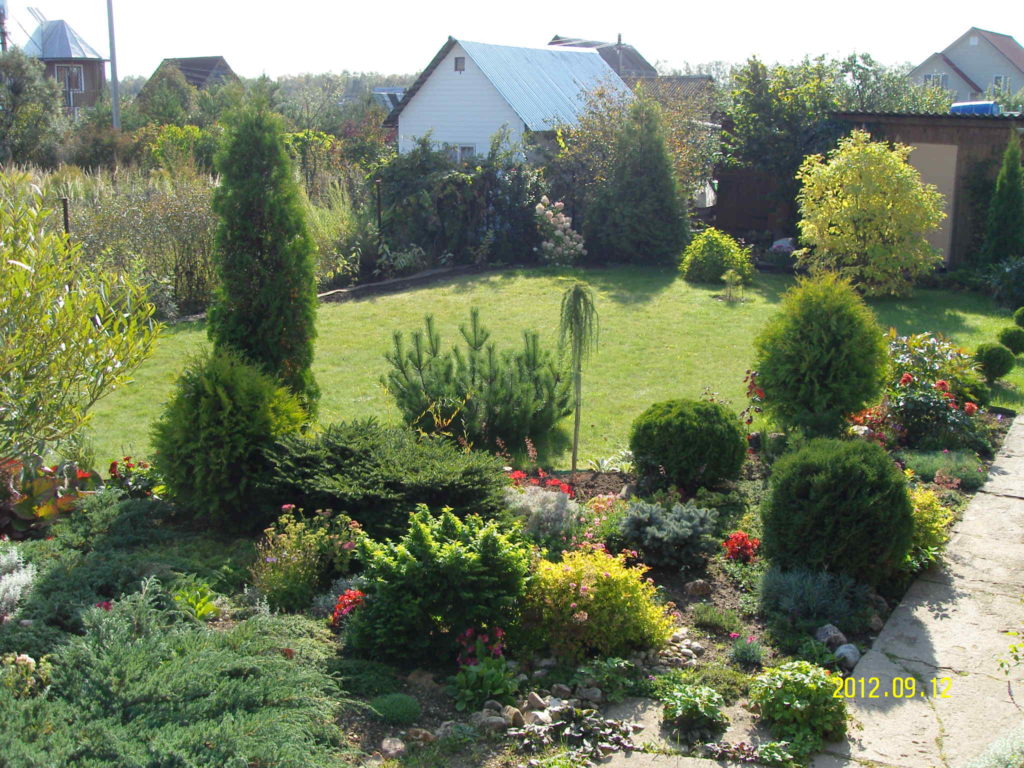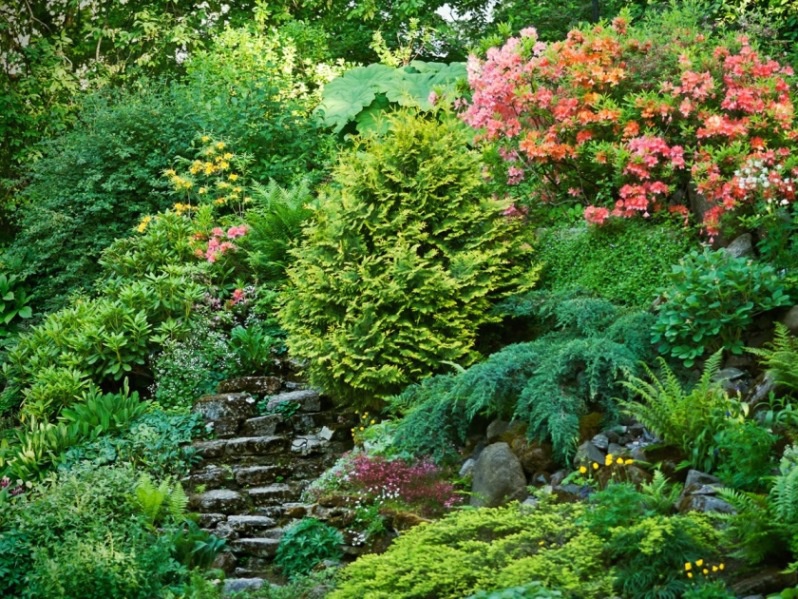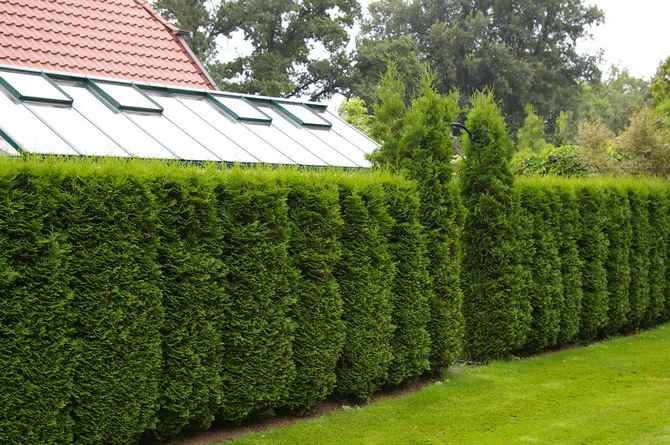Plant thuja (lat. Thuja), or life tree, belongs to the genus of gymnosperms of coniferous plants of the Cypress family, like juniper, sequoia, taxodium, cypress and cypress. Thuja was brought to Europe from East Asia or America. The Latin name of the plant has an ancient Greek root, meaning "sacrifice", "incense" - apparently, there is a connection between the name of the plant and the smell of aromatic thuja rocks ritually burned as incense. The genus includes 6 species, whose representatives sometimes live up to 150 years, although there are also much more mature specimens. In addition to some species, about 120 varieties of plants are grown in the culture, differing in the color and quality of the needles and the shape of the crown. thuja in landscape design is one of the basic plants and is grown as a tapeworm or in a group, and is also used to decorate alleys, borders, and create hedges.
Listen to article
Thuja tree - description
Thuja - evergreen shrubs or trees, sometimes in nature reaching 70 m in height with a trunk diameter of 6 m. In culture, thuja rarely grows above 11 meters. In young thuja, the needles are needle-shaped, soft, light green in color, while in adults the leaves are darker green, crosswise opposite, scaly. Tui are monoecious plants, their fruits are oval or oblong cones with flat seeds that ripen in the first year. Thuja is not capricious in care, smoke-resistant, cold-resistant, and such a species as western thuja tolerates even cold winters well.
Planting thuja
When to plant thuja.
Before you plant a thuja, you need to choose a suitable site for it. Thuja is photophilous, however, from being in the sun for a whole day, it becomes dehydrated, and this leads to the fact that thuja does not tolerate winter well. Therefore, the place for the thuja should be bright, but at noon the sun should not fall on it. In addition, thuja does not tolerate drafts. Soil for thuja is desirable nutritious - soddy land with the addition of sand and peat, although thuja grows on less rich soils - in marshy, sandy loam and clay. You can plant thuja in spring or autumn, but planting thuja in autumn does not give you confidence that the plant will have time to adapt to open field before winter.
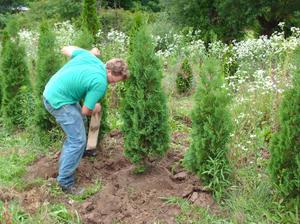
How to plant thuja.
The size of the pit for the arborvitae depends on the size of the root system of the seedling - it should be 35-40 cm wider and 15-30 cm deeper than the earthen clod of the arborvitae. If you plant several plants, the distance between them, depending on the size of adult plants, is maintained from 1 to 5 m. When planting thuja along the alley, the distance between seedlings is kept at 3.5-4 m. A mixture of soil with a small amount of compost or well-rotted manure. Before planting, the roots of the seedling should be kept in a container with water until air bubbles stop coming out. After that, put the tree in the center of the hole, straighten the roots, make sure that the root collar is just above the soil level, fill the hole with a good soil mixture, carefully and carefully compact it, being careful not to damage the base of the trunk, and water the seedling abundantly at the rate of 1.5 - 2 watering cans per plant. When the water is absorbed and the earth settles slightly, mulch the trunk circle with wood chips, peat, compost or pine bark - the mulch will protect the thuja roots from too hot or too cold weather and retain moisture in the soil for a long time. However, do not allow the mulch to cover the trunk or lower branches of the plant - they can get wet under the mulch.
Thuja care in the garden
How to grow thuja.
Thuja is very responsive to watering, especially she likes sprinkling. In the first weeks after planting, thuja seedlings are watered weekly at the rate of 10-50 liters of water per seedling, depending on its size. If you arrange sprinkling for young plants, this will not only moisten the soil and water the roots of the thuja, but also wash off the dust from the needles, the stomata of the leaves will open, and it will become much easier for the plant to breathe, respectively, all physiological processes will proceed faster. After watering, the soil around the thuja is loosened, but not deeper than 8-10 cm, since the root system of the plant is superficial.
Thuja is fed in the spring with complex mineral fertilizer, for example, Kemira-universal solution at the rate of 50-60 g per m². If you fertilized the soil when planting, then the next time you need to feed the plant will only be after two years.
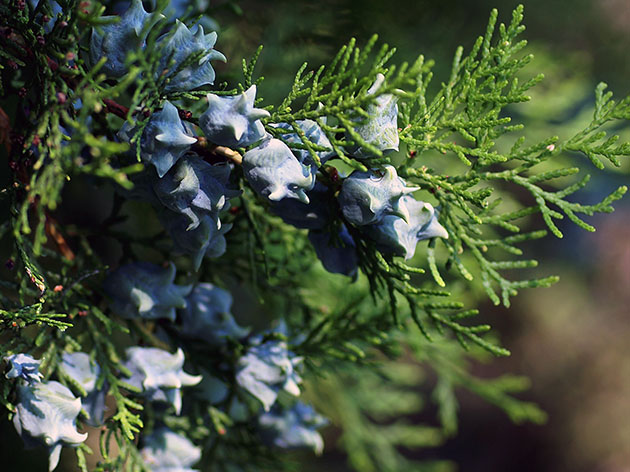
Thuja responds well to pruning - the more often and stronger it is cut, the thicker and more magnificent it becomes. There are no strict deadlines for pruning, but it is better to do this in the spring, before the buds open. If you grow a hedge from a thuja, then you have no choice: you want it, you don’t want it, but you have to cut it. A thuja growing as a solo plant will need at least sanitary and thinning pruning. But if the thuja grow in a group, you will have to form their crowns, otherwise they will look messy. Start forming the crown when the plants have already grown to the size you need. Sometimes one haircut a year is enough - in the spring, but usually there is a need for re-pruning - in late summer or early autumn. Some forms need constant adjustment of the crown, but no more than one third of the shoot can be cut at a time, otherwise the plant may weaken. The first pruning of the thuja is carried out no earlier than at 2-3 years of age. Use a sharp, powerful pruner for cutting so that it does not chew the shoots and does not leave dents on them.
That's like all the information on how to care for thuja. As you can see, planting and caring for a thuja will not take you much time, but healthy appearance This elegant evergreen is sure to make your garden more beautiful.
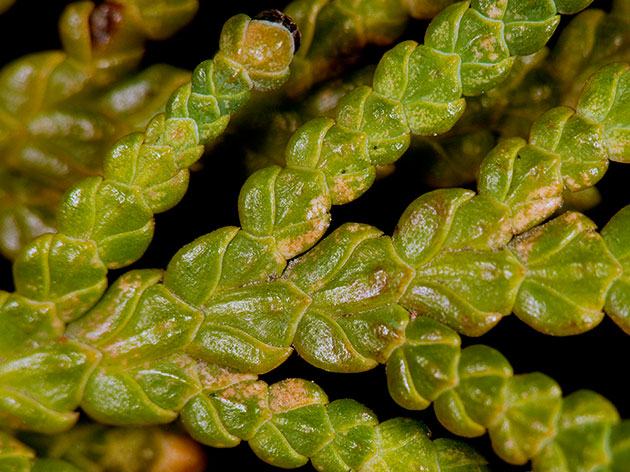
Tui transplant.
For various reasons, we sometimes have to transplant already mature plants from one place to another. Conifers are easy enough to transplant if you know how to do it. Around medium-sized plants, you need to pierce the soil in a circle with a sharp shovel at a distance of 40-50 cm from the trunk, then carefully pry the plant along with the near-stem area outlined by a circle, remove it from the soil, transport it to a new place with a wheelbarrow, trying not to destroy the earthen lump, and immediately to plant. Larger plants need to be bayoneted a year before transplanting, so that they have time to grow new young roots inside an earthen clod limited by a circle - as a result, the earth will not fall apart when removed, and transportation will be painless for the plant. In a new place, thuja takes root easier than other coniferous plants.
Pests and diseases of thuja.
Thuja is prone to such fungal diseases as brown shutte, fusarium and cytosporosis, which affect the shoots and needles of the plant. In the fight against them, treatment with Bordeaux liquid or Kartocide is used - thuja treatment begins in the spring and is repeated every two weeks until the thuja recovers.
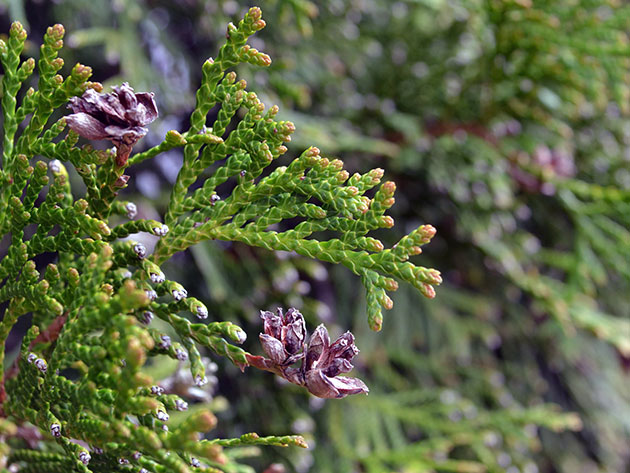
Tui reproduction
How to propagate thuja.
Thuja reproduces both generatively and vegetatively. If you propagate species thuja, then you can do it with seeds. But varieties and forms must be propagated vegetatively - by cuttings or by dividing the bush, since the thuja from seeds does not retain the varietal characteristics of the parent plants.
Reproduction of thuja cuttings.
Propagation of thuja by cuttings is carried out with the help of lignified two-three-year-old shoots cut in June, 25-40 cm long or semi-lignified shoots of the current year, 10 to 20 cm long. planted to a depth of 1.5-2.5 cm in a mixture of equal parts of soddy soil, peat and sand, spilled for disinfection with a warm solution of potassium permanganate, and cover the planting with plastic wrap. For successful rooting of the cuttings, it is necessary to maintain high air humidity in the greenhouse without waterlogging the substrate, so the soil is not watered, but sprayed from a sprayer. As soon as the cuttings take root, they begin to ventilate and gradually harden until it is time to remove the film. With the onset of late autumn, the cuttings are covered with dry leaves, sawdust, and preferably spruce branches, and if the temperature drops to -5-7 ºC, a film is thrown over the spruce branches.
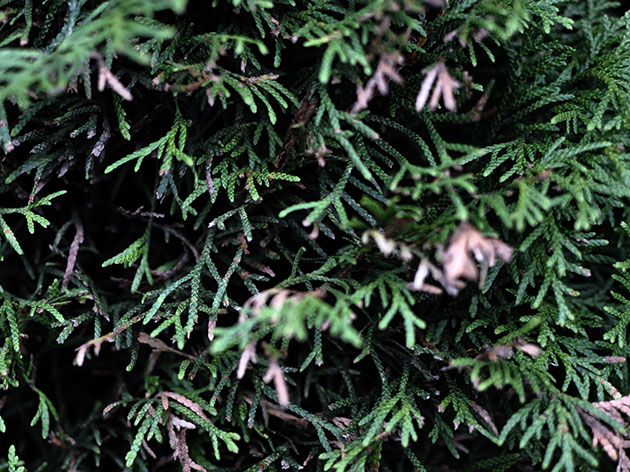
Growing thuja from seeds.
In order to grow thuja from seed, you will need from three to five years. You need to sow only freshly harvested thuja seeds, having previously subjected them to natural stratification from autumn to spring under snow or in the refrigerator. In spring, the seeds are sown in beds in partial shade, to a depth of only 0.5 cm, and lightly sprinkled with sawdust of coniferous trees. Then the crops are covered from the sun with shields, and the soil is kept loose and slightly moist all the time. After the emergence of seedlings, the site is mulched with peat. Twice a month, seedlings are fed with a solution of complete mineral fertilizer. During the first season, seedlings usually grow up to 7-8 cm. Young arborvitae are covered with spruce branches for the winter, and on top with a film. The next spring, the shelter is removed, and the seedlings are looked after, as last year - they mulch the soil, water, remove weeds and feed. On the third spring, when the plants reach a height of 50 cm, they are planted in a permanent place.
Thuja in the country in winter
Thuja in autumn.
In the fall, both watering and feeding the thuja are stopped, since the plant must prepare for a dormant period.
How to cover thuja.
Young plants that are under five years old should be covered with spruce branches for the winter. Before you cover the thuja for the winter, it is highly spudded, and the trunk area is mulched with a thick layer of peat. Mature plants hibernate without shelter, but it is necessary to mulch the area around them.

Thuja wintering.
If too much snow falls in winter, it can break the dense crown and branches of even an adult large thuja. To prevent this from happening, thujas are tied with twine for the winter. At the end of winter, so that the thuja does not suffer from the strong spring sun, a non-woven covering material is thrown over it. Sometimes, from sudden changes in temperature in winter, cracks form on the bark of the thuja. In the spring they are covered with garden pitch and the bark is tightly pulled together so that the wounds heal.
Types and varieties of thuja
Thuja western (Thuja occidentalis).
When we talk about cultural thuja, we first of all mean the type of western thuja - it is it that is represented in our gardens, parks and squares by a huge number of its varieties, forms and varieties. In Europe, it was introduced into culture in the 16th century. Large specimens of this species reach a height of 8-12 m. Western thuja is a long-liver among trees, it can live up to a thousand years. At a young age, it is a pyramidal tree, later the shape of the crown becomes ovoid. For landscaping, plants of a pin-shaped, cone-shaped or columnar shape are usually used. For example:
- – thuja brabant- a tree 15-21 m high with a conical crown shape with a diameter of 3-4 m. The bark is exfoliating, gray-brown or reddish. The needles are green, scaly. Tui cones of this variety are oblong-ovate, Brown color, up to 12 mm long;
- – thuja Smaragd- This is a squat variety up to 2 m high with a cone-shaped crown and weak branching. On vertically arranged shoots, glossy evergreen branches are far from each other. Planting and caring for the Smaragd thuja is carried out in accordance with the recommendations in this article. The variety is in great demand.
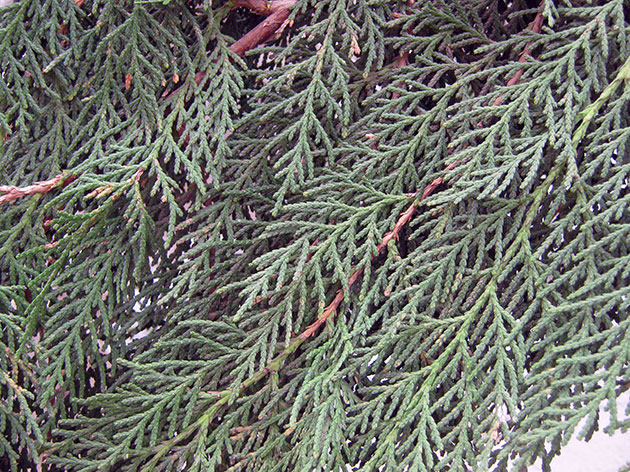
Among the group of varieties with a spherical crown shape, the most famous are:
- – thuja Danica- a dwarf form of thuja of Danish selection with a gray-brown or reddish exfoliating bark, thick, soft, shiny green scaly needles, which acquire a brownish tint in winter;
- – thuja woodward- spherical thuja of dwarf size - not higher than 2.5 m with a crown diameter of 5 m. Its shoots and branches are straight and flat. The needles are dark green.
Attract gardeners and varieties of cascading, filamentous form, which include:
- – thuja Filiformis- a tree up to 1.5 m high with a dense rounded or wide cone-shaped crown, long filiform hanging shoots that almost do not branch. The young needles are light green, in winter it becomes brown.
Not so long ago, a heather-like form of thuja was bred, for example:
- – thuja erikoides- no more than a meter high, reminiscent of juniper, with a rounded multi-apex wide-conical crown, numerous thin flexible shoots, straight or bent, and subulate soft needles, dull yellow-green above, gray-green below. In winter, the needles turn brown.
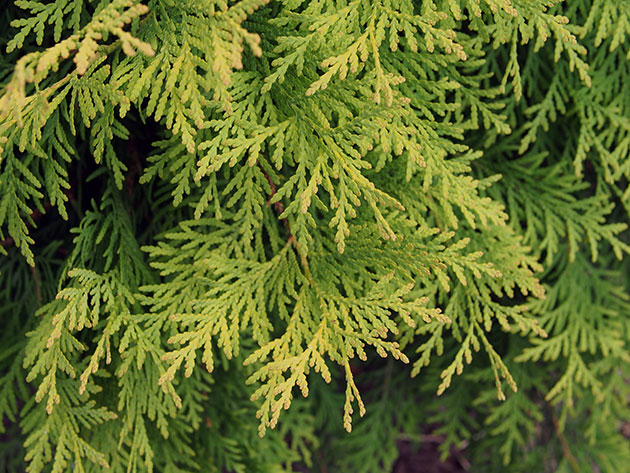
A form was also developed with two types of needles on one plant - needle-shaped and scaly, with a strange growth of the crown: at the age of 8-10, it breaks up into several peaks and instead of one thuja, a group of plants is formed.
Thuja folded (Thuja plicata).
The culture also cultivates a species of thuja folded, or thuja giant, which grows naturally along the Pacific coast and is the highest mountain species of thuja. It reaches a height of 60 m with a trunk diameter of 3-4 m, although its achievements in culture are not so high. Thuja folded has several decorative forms, of which the most famous is Zebrina.

Thuja Korean (Thuja koraiensis)
is a wide shrub or tree up to 9 m high. The needles are elegant, whitish, almost silvery. However, this attractive plant needs shelter in winter.

Thuja Japanese (Thuja standishii)
grows in its natural habitat, in the mountains of Central Japan, up to 18 m in height, it has a wide cone-shaped crown with copper-red bark and branches silvery on the underside, which, when rubbed, smell of eucalyptus caramel and lemon. In cool areas, Japanese thuja grows slowly; in warm areas, growth accelerates noticeably.
4.5 Rating 4.50 (44 votes)
Amateur gardeners, especially beginners, often choose an unpretentious beauty for their garden - thuja. This plant tolerates frost, drought, lack of sunlight and does not impose special requirements on the composition of the soil.
Another feature of thuja is loyalty to the environment, that is, the plant tolerates close proximity to plants and factories.
How and when to plant thuja?
it coniferous plant can be planted in the ground both in spring and autumn.
Features of planting thuja in the fall
Is it possible to plant thuja in the fall- the question is very ambiguous. The thing is that this is a southern plant and best time for its planting - spring, since in the fall the probability that the thuja will take root decreases to 10%. Therefore, it is very important to follow the rules of planting in the autumn.
 First, you need to prepare a hole, the size of which should be twice as deep and three times the size of the root ball (usually about a meter). Old compost, black soil, peat are laid at the bottom. If the soil is heavy and damp, good drainage is preliminarily made (layer thickness 10-15 cm) from broken bricks, large pebbles, expanded clay or crushed stone.
First, you need to prepare a hole, the size of which should be twice as deep and three times the size of the root ball (usually about a meter). Old compost, black soil, peat are laid at the bottom. If the soil is heavy and damp, good drainage is preliminarily made (layer thickness 10-15 cm) from broken bricks, large pebbles, expanded clay or crushed stone.
The root ball is set in such a way that the neck of the plant is located exactly at ground level; The roots are sprinkled with earth and rammed. After that, the plant must be watered abundantly.
When planting, make sure that the distance between the thujas is at least a meter. Although the plant is unpretentious, its growth rate directly depends on the chosen landing site. Thuja grows very quickly in a site protected from the wind with well-moistened fertile soil.
The plant has a well-developed, but superficial root system, which needs mandatory mulching. For this, peat, pine nut shells, and bark are used. Mulching is especially important during autumn planting, as it protects the plant from drying out and freezing. If the thuja is planted in the fall, the soil should not be fertilized. Top dressing of the plant is carried out only next spring, using special fertilizers for coniferous trees.
For better survival of the root system, seedlings must be treated with root or heteroauxin. The crown can be treated with anti-stress drugs. During the first week after planting, it is enough to spray the plant once a day, then twice a week until the first frost.
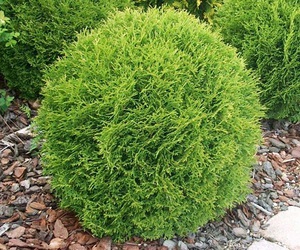 It is better to plant thuja in the morning or in the evening.. If planting is done in hot weather, the plant should be darkened with burlap or kraft paper. For dwarf thuja, you can use a cardboard box. Shelter must be removed when the leaves begin to actively bloom.
It is better to plant thuja in the morning or in the evening.. If planting is done in hot weather, the plant should be darkened with burlap or kraft paper. For dwarf thuja, you can use a cardboard box. Shelter must be removed when the leaves begin to actively bloom.
In autumn, the thuja may turn yellow and begin to shed its needles. This should not be frightened, since this condition is typical for this type of plant.
To plant or transplant a plant in the fall, you need to know about certain rules:
- Do not plant thuja in late autumn, as a fragile seedling will be very difficult to survive the winter. The ideal planting time is September - early October, that is, before the appearance of frost.
- Before the appearance of the first stable cold weather, the roots of the plant should take root well, therefore, in order to protect the roots from frost, the area near the thuja can be covered with fallen needles or compost. Fallen leaves not only create heat and retain moisture, but also enrich the soil with minerals and improve its composition when rotting.
- Heavy snowfalls can damage the fragile branches of a tree, so it is necessary to shake off the snow from them. •
- To protect the thuja planted in autumn from sunburn and cold, it must be covered with burlap. In no case do not use polymeric or synthetic materials for this purpose, as they are not able to protect the plant from frost.
- To ensure air circulation, do not overtighten the burlap. Otherwise, the plant may suffer from damping out during the thaw period.
Following these simple tips, you will greatly facilitate the wintering of your seedlings.
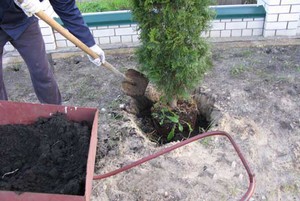 When buying a thuja seedling (like any other coniferous plant) attention should be paid to the location of the root system. Choose only those pots in which the roots of the plant are completely covered with soil. It is better to purchase a seedling in a container or wrapped in burlap. This will help the plant take root better, which is especially important when planting in the autumn. It should not be too long with planting thuja from a pot or container into the ground. The sooner you do this, the greater the chance of a good survival.
When buying a thuja seedling (like any other coniferous plant) attention should be paid to the location of the root system. Choose only those pots in which the roots of the plant are completely covered with soil. It is better to purchase a seedling in a container or wrapped in burlap. This will help the plant take root better, which is especially important when planting in the autumn. It should not be too long with planting thuja from a pot or container into the ground. The sooner you do this, the greater the chance of a good survival.
We plant thuja in the spring
To facilitate transplantation it is recommended to use plants with a closed root system. It is better to plant thuja in partial shade or in the sun, since in a shaded place the crown of the plant will be weak and not lush. The quality of the soil does not matter much - it can be peaty, slightly acidic, clay or sandy soil. But still, it is better to use peat-leaf soil with a small amount of sand in a ratio of 2/1/1.
How to plant thuja in the spring?
- Depending on the desired landscape and thuja variety, the distance between seedlings should be from one to five meters.
- being prepared deep hole with a diameter of 0.8–1 m and a depth of 0.6–0.8 m, depending on the earthy clod that is present on the root system.
- When planting a plant, it is recommended to apply organic fertilizers: 10–15 kg of organic matter and 1–3 kg of ash.
- Any operations with the plant should be done with great care in order to avoid damage to the root ball.
- After planting, fertilizer should be applied - "Epin".
- With breaks of 14 days, it is necessary to additionally feed the plant with potassium and phosphorus.
- You need to water the thuja once a week. In the case of a dry spring, watering is carried out twice a week.
How to plant thuja with seeds?
 In the spring, thuja is planted with seeds into a small vessel. The soil is preliminarily prepared, which includes garden, leafy, coniferous soil and sand. The container with seeds should be covered with glass.
In the spring, thuja is planted with seeds into a small vessel. The soil is preliminarily prepared, which includes garden, leafy, coniferous soil and sand. The container with seeds should be covered with glass.
It needs to be ventilated daily. The seedlings that have appeared are carefully transplanted into separate pots, on the bottom of which drainage is laid from broken shards or gravel mixed with coal.
Planting thuja cuttings
Plant cuttings are taken after the shoots have already grown.(July August). In this case, only cuttings from a young thuja are used, the age of which does not exceed 2-3 years. The length of the cut cuttings should be at least 20 cm, while leaving a small heel (a piece of the wood of the tree itself), which, after cutting, is cleaned with a knife.
Then cuttings should be treated with a solution of heteroauxin and planted in prepared soil, covered with sand and peat. Treat the soil with a solution of manganese. Loosen the soil, pour water and plant the plant to a depth of 2 cm. As soon as the cuttings take root, they should be treated with a fungicide.
What can be planted next to the thuja?
The plant goes well with deciduous shrubs and flower beds:
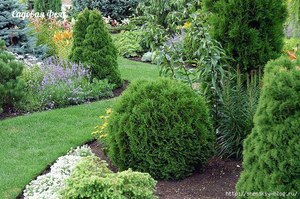
Thuja does not get along well with peonies and asters, so it is not recommended to plant them nearby.
Ephedra are good both in the city - on the territory of alleys and parks, and on suburban area. Throughout the year, they decorate the place in which they are placed. Today we want to offer you information about the types of thuja, the features of planting and caring for them.
In Latin, the name sounds like "Thuja", it came from Greek word meaning "incense". When thuja wood burns, a pleasant specific aroma spreads around. The American continent or East Asia are the native habitats of tui. These representatives of the cypress family grow in the form of a shrub or tree. There are instances reaching beyond long years his life height of seventy meters. The shape of the crown is varied: spherical, pyramidal, columnar, cone-shaped. It is formed by numerous shoots branching in one plane. In young plants, the structure of the leaflets is needle-like, as they grow older, they become flat-scaly. The scales are densely superimposed on each other. The color of such a peculiar foliage can be not only different shades of green, but also variegated, lemon, bronze, reddish. These monoecious gymnosperms produce oval or oblong cones with two to six pairs of scales. Those at the top are sterile, the rest contain one, two or three (which is rare) ovules. Seeds are flat with narrow "wings". Ripening occurs already in the first cycle of development of this conifer. What are thuja?
Western - it is she who can most often be seen in parks, squares, on large garden plots. It grows slowly, resistant to gusts of wind, resistant to frost. It has many varieties and original varieties. Massive representatives can approach the mark of 8-11 meters in height. Most of the thuja of this species are long-lived, living for a thousand years. The average age of cultural forms is 150 years. Small thujas look like pyramids; over the years, their crown changes and becomes ovoid. The color of the needles is more often green, in winter the “outfit” may turn brown or turn brown, but in the spring the thuja will again “change clothes” into a summer “suit”. Against this background, the flowers are hardly noticeable, they are yellow-green. But the color of the cones is red-brown. Many designers for landscaping choose plants with a cone-shaped, columnar or pin-shaped crown shape. Common varieties:
A few more interesting varieties of thuja:
Breeders managed to bring out such a form of thuja, on which two types of needles are simultaneously present - needles and scales. At about the age of eight to ten years, this thuja breaks up, as it were, into several tips. It seems as if not one thuja was planted, but a whole group.
In horticulture and park construction, the eastern thuja is also used (otherwise, the eastern biota). Now in the genus "thuja" it is not considered, it has been transferred to a separate monotypic species. Experts gave this species the name oriental flathead. How is thuja used in landscape design?
The abundance of forms and varieties allows design specialists and ordinary summer residents who love conifers to translate into reality different variants and ideas for placing tui:
Where and when to plant thuja?
Now another question arises - what kind of soil is needed for thuja? Open ground for this conifer is desirable nutritious (with the presence of soddy soil, peat and river sand), constantly moistened and loose. This conifer will grow in both clay and sandy loam, where there are few nutrients, but then it will not look so attractive. Thuja loves light, but if she is under intense sunlight all day, she loses a lot of moisture. Prolonged dehydration is fraught with the fact that it will be difficult for the thuja to survive the winter months. Try to choose a place for the thuja that will be bright, but at noon there should be a shadow or partial shade. If the thuja is constantly in the shade (especially for variegated and yellow-colored forms), then the color of its needles will not be so intense and shiny. In such conditions, the thuja thins out, “bald patches” are noticeable on it. And it gives more cones in the shade. How to plant thuja?
How to grow thuja?
Such a problem can also upset gardeners - yellowing of the needles, its fall from the branches. Several reasons why this problem happens: It should be remembered that there are types and varieties of thuja, in which, with the advent of winter, the needles turn brown or turn brown. This phenomenon is quite normal. This is the result of adaptation to the cold season. If the needles turn yellow and fall off after wintering, then the condition of the tree or bush can be improved by spraying the branches weekly with a solution into which a biostimulant has been dropped (NV-101, Epin, Zircon). Thanks to these means, the bare branches are soon covered with young needles again. How to transplant thuja?
It happens that the thuja has taken root, but the summer resident understands that it is necessary to move it to another place on the site. The reasons for making such a decision may vary. To begin with, draw a circle with a stick or a sharp object so that there is an indent of 50 centimeters from the trunk. Poke the soil along this circle with a sharp spatula. With gentle movements, pry the soil around the entire circumference of the near-stem space. With assistants, remove the thuja from the ground, put it on a cart and, holding it, transport it to a new landing site, where the landing pit is already ready. How to propagate thuja?
In several ways, thuja can be successfully propagated: vegetative and generative. Usually cuttings, horizontal cuttings and division of the overgrown bush are used to spread varieties and forms. At the same time, the characteristic features of the "parents" are preserved. But species thujas are successfully propagated by seeds.
In order to grow thuja from seeds, it is necessary to stock up on freshly picked cones. From autumn until the arrival of spring, they must be kept in the refrigerator or under the snow so that they stratify.
The division of the bush is advisable to carry out for the propagation of multi-stemmed compact varieties of thuja. First, the bush is spudded to stimulate the formation and growth of additional roots. If the thuja is spudded in the spring, then such roots will form by the fall, if in June or July, then the root-forming process will sufficiently occur in the next season - by May or June. Then the plant can be carefully dug up and divided into several independent specimens, which are then moved to pre-prepared planting pits. How do thuja winter?
If the autumn is dry, there is little rain, then in October be sure to generously water the thuja so that they winter better. Young plants that have not reached the age of five are highly spudded in autumn, mulching the soil near the stem with peat chips. Then they are covered with spruce "paws". Mature plants can winter without shelter. But mulching is still worth doing (in October or November). Heavy snowfalls can break the branches and dense crown. To keep the thuja whole, before winter they are tied using twine. In specialized stores, you can even find covers for the thuja crown. In the spring, the burning rays of the sun can burn the crown of the thuja, to prevent burns in the spring, throw a “non-woven fabric” on the thuja. If after winter you notice cracks on the bark of a tree, then cover them with garden pitch, pulling off the bark, helping the wounds to heal. Now you know how to care for evergreen thuja. Properly take care of these elegant conifers, then they will always look healthy for many years. Being close to these plants (at least 30 minutes) calms the nerves, helps to put thoughts and emotions in order. And also thujas clean the air well next to them, saturate it with oxygen, release phytoncides with bactericidal properties. Thuja, photo
|
Thuja confirms its second name - "life tree" - with emerald green soft needles. An evergreen plant will delight with its magnificent view for a long time, if you first figure out how to properly plant a thuja behind it, and then start work.
The life tree is unpretentious, has long been successfully used in landscape design.
Is it necessary to plant thuja near the house and in the yard?
Only five species of trees and shrubs of the genus Thuja (Thuja) of the cypress family gave rise to hundreds of wonderful varieties. In the Russian expanses, T. western is more common than others - a tree with a conical crown shape, reaching a height of 15 m and a width of up to 5 m. Flat, raised branches carry evergreen scaly leaves to the sun. Inconspicuous yellow-green flowers give rise to small brown oval buds.
If someone else doubts whether it is possible to plant thujas near the house, then they should find out that these coniferous plants perfectly protect against noise, dust and harmful emissions. Just do not place large trees too close to buildings - the root system is superficial and rather branched.
How not to confuse thuja with other similar plants?
A similar shape of the crown and the structure of the needles of the eastern biota, but the shoots of the thuja are dotted with tiny glands with an essential oil that exudes a pleasant aroma. Both species change color from dark green to light brown in winter and during drought. Those who are interested in whether it is possible to plant thuja in the summer should be aware that a change in color does not necessarily mean that the tree has died.
Created cultivars with golden, silvery and variegated needles, bred dwarf forms suitable for growing in containers and pots. The most popular are thuja with a columnar, pyramidal and spherical crown. But how to plant in order to preserve the decorative properties of each variety? Let's find out the requirements for growing conditions using the example of western thuja. This coniferous plant endures frosty winters and regular pruning.
How to choose a place and time of landing?
Grow thuja in groups and singly, used to create hedges. Is it possible to plant thuja in the yard , if it is flooded with sun? The plant does not tolerate direct rays throughout the day, but in full shade the crown becomes loose. If there is a problem where to plant, and it is possible to choose a site, then a partially shaded place with a cool and humid microclimate should be preferred.
The question of when to plant thuja in autumn or spring is not fundamental for the frost resistance zone No. 5, which prevails in Russia. Moreover, when transplanted with a clod of earth, the survival rate is almost 100%. And yet, when is it better to plant a thuja? Preferred periods are March and October.
What kind of soil is best?
Knowing in which land to plant thuja is very important to increase survival. The best option is a moist, well-drained substrate. Thuja grows well on a mixture of soddy land with peat and sand.
Many summer residents and gardeners doubt whether it is possible to plant thuja in clay soil, is this heavy, water- and air-tight soil suitable? Too dense earth is improved with compost and sand, lime is added to eliminate acidity.
How to place plants in a group planting?
At what distance do thujas plant:
- one row of hedges - 1 m;
- two rows of trees - 1.5–3 m;
- alley of large-sized trees - 4–5 m.
The depth of the pit for a young plant is approximately 70 cm, the width is up to 1 m. If large-sized plants are transplanted, then the pit is dug out more than an earthen clod by 20 cm in height, and 50–70 cm in diameter.
How to plant thuja in spring:
- It is desirable to prepare a hole since the fall, in extreme cases - a week before planting.
- At the bottom, drainage is arranged from small crushed stone or gravel (15–20 cm).
- Pour soil into the hole with a layer of about 15-20 cm.
- You can add nitroammophoska - up to 100 g per seedling, organic matter - 50 g per 10 kg of soil.
- Place the tree in a prepared planting hole (or hedge trench).
- They pour the soil, shake it off a little from the roots and knock under them.
- Gradually fall asleep all the earth, carefully tamp and water.
- The root neck should eventually be at the level of the soil.
- Fertilize with a growth and root formation regulator - "Kornevin" or "Epin".
It is magnificent both on the lawn in front of the house, and in the hedge, and in the winter garden, and on the alpine hill.
And if you consider that thuja is a wonderful natural air freshener (it has a delicate coniferous aroma) and grows well in conditions of moderate gas pollution, then it is simply created for hedges! The thuja does not tolerate high gas content well: it turns yellow and may die.
In general, the Indians (and the thuja came to Europe from North America) called this plant the tree of life, and, of course, they were right, since even one glance at its emerald, flattened needles is enough to cheer you up and forget about troubles.
However, thuja is also known for its medicinal properties, so you are definitely not mistaken if you decide to find a place for her in your garden.
And so that she likes this place, choose it using our simple tips.
Remember: thuja loves a lot of light, but does not tolerate constant sun, however, as well as constant shade.
Therefore, the best option would be to plant a thuja in a place protected from the wind, preferably in partial shade.
If this is a hedge, then the plants are planted at a distance of at least a meter from each other, and if the alley is from 2 to 3, if the variety is large, then you need to retreat more, because the tree will grow in breadth.
In any case, if you buy a thuja seedling, take an interest in its variety, height and width of growth, and other features.
Do not be sick!
Tui are rarely affected by various types of diseases, but they also have enemies.
The main ones are different kinds pests: mushrooms, thuja aphid and thuja false scale, the needles affected by them turn yellow and fall off.
To combat fungi, Bordeaux mixture or cartocid is used. Trees are treated every two weeks until complete recovery.
Be sure to follow the instructions for the preparations so as not to damage the tree!
They fight thuja aphids in the following way - at the beginning of summer, trees are treated with any of these drugs: Inta-vir, Fumanon, Kemifos, Aktellik, follow the instructions on the packages.
When false shielding, use "Confidor".
Cut off the march!
As mentioned above, thuja is a fertile material for creating compositions, but it needs the right haircut.
It is better to start making "hairstyles" for the tree no earlier than in the third or fourth year, and cut it off - by more than a third of the branch.
Shrunken shoots are removed in early spring, and a crown is formed after the branches form, in early summer.
Viktor Sergeev



